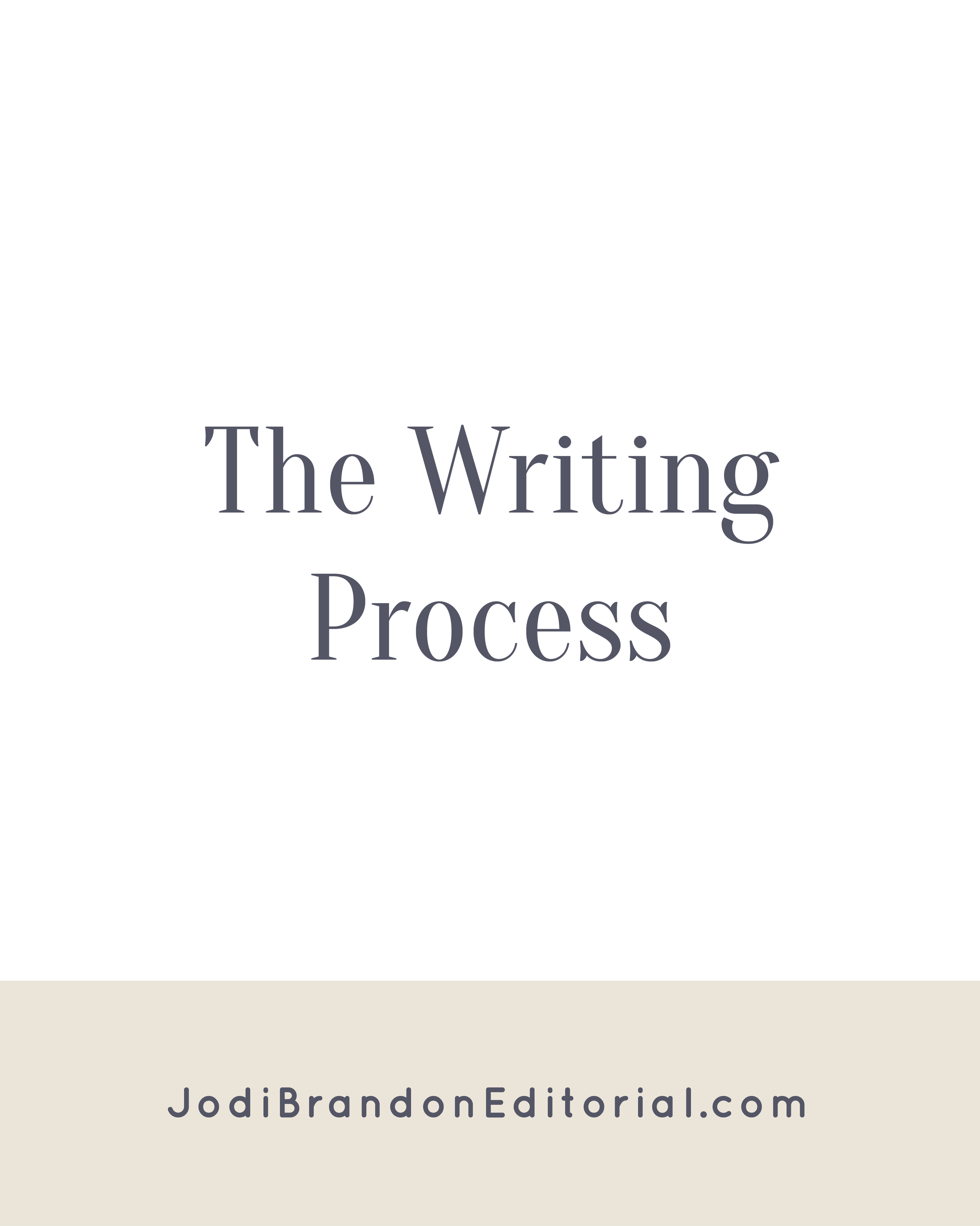The Writing Process
Sometimes you’ll see the writing process as having four steps: writing, revising, editing, and publishing. In that scenario, prewriting is included in the writing phase. Prewriting is a separate step from writing. I cannot over-emphasize that point! If you sit down to write 50,000 (or more words) with a topic and a few key points, but nothing else, you’re in trouble. Prewriting is the legwork and preparation to make the actual writing easier and faster. So really, the writing process has 5 steps:
Prewriting
Drafting
Revising
Editing
Publishing
Prewriting
When people say they wrote a book in 30 or 60 days, generally it’s because they had already completed their interviews and research, and that time was spent JUST writing. Or, you know, they’re Beyonce and have a team of people doing the research for them concurrently. But since you’re not Beyonce, let’s figure out how to make the most of the prewriting phase so that when you sit down to write your first draft, you’re ready to go. I’ve written about prewriting extensively on the blog, so if you need a refresher, check out this post.
Brain Dump (or Outline)
You’re familiar with the brain dump, right? (If not, check out this post.) All you need are a writing instrument, a timer, and a piece of paper. That’s it! The key is to pick the right amount of time. I like the three- to five-minute range. That’s enough time to get into a groove (after those first seconds of “Oh my gosh, I can’t think of anything to write”), but not so much time that you run out of things to write. I do this process several times, going deeper each time, until I can start to see my book contents come together. Once I have this step, I then look at what existing content I have that can be repurposed (blog posts, newsletters, etc.)
Research
If you sit down to draft your book without doing research, your first draft will be a shell of a manuscript rather than a workable draft. You’ll have some text, followed by a highlighted area on the computer screen where you inserted a comment to yourself to “Look up statistic about video marketing,” followed by text.
This situation will do nothing but slow you down later. If you have your research complete and at the ready, you can draft much quicker (not to mention, more efficiently). This step includes interviews (and transcribing them!). Word to the wise: Figure out a method for organizing your research. Maybe that’s Trello or Evernote. Maybe it’s Google Drive. Maybe it’s Word. Whatever works for you is okay; just be sure to have a system.
Taking notes on your book is not the same as writing the first draft. —Monica Leonelle
So many people think that researching and taking notes is the same as writing. That couldn’t be further from the truth. Surely you’ve heard by now that we’re all wrong about multitasking: that it actually DOESN’T work. Same concept here. Let’s say you’re finally into a writing groove and you come upon one of the holes in your manuscript that I described in the last section. You think, “Let me look that up quickly.” Next thing you know, two hours have passed and you’ve gone down the rabbit hole known as Google. Oh, and you never found the statistic you were looking for.
Drafting
Once your research is done, it’s time to write. Make a plan, and then establish a writing routine to get your manuscript written in a realistic time frame. You are not going to find the time to write a book; you must make the time. You have a family, you’re running your business, you have social and volunteer commitments, you have extended family obligations — and you have things that you just plain don’t want to cut out of your life (yoga class, book club, weekly happy hour or coffee with a friend). Be honest and realistic when setting this plan. We’ll talk more next week about establishing a writing habit if you don’t already have one, as that’s key to your writing routine.
You are not going to find the time to write a book, you must make the time. (Tweet)
“Serious writers write, inspired or not. Over time they discover that routine is a better friend than inspiration.”
— Ralph Keyes
There’s no secret to this stage of the process. You simply take your book contents (created from brain dumping) and do the work, adding in research and interview quotes to support your points along the way. If distraction is an issue for you, I’ve created a list of popular apps that offer a distraction-free writing environment.
You’ll likely have more cleanup work to do in the self-editing and revising stage, but if that’s what it takes for you to actually get a draft finished, then by all means, speak away.
After you’ve finished writing, give yourself a break. Get away from the text for a while. Your goal when revising is to improve your manuscript. If you haven’t taken a proper break, you won’t do a great job of revising. Revising is when you clarify where needed, remove tangents and extraneous text, and reorganize sections (or chapters) as needed. The amount of revising you do depends on your writing style, how much prewriting you did, and your natural writing ability. There’s no set rule regarding the “right” number of revisions (though I can tell you — with confidence — that it’s more than one!).
Editing
I won’t rehash the steps involved in self-editing your manuscript (I’ve covered that before), but I will say this: Before you work with a professional editor, you should self-edit your book. You may not an expert in grammar or transitions between paragraphs or concise writing, but you’ll be amazed at what you can find and clean up before a professional editor even looks at your manuscript.
When you publish traditionally, your publishing house will assign a production editor to your book. When you self-publish, it’s up to you to find (and pay for) an editor to have your book edited before publication. You’re the boss when self-publishing, so of course you don’t have to have your book edited, but that would be a mistake for one simple reason: You’re an expert in your industry; an editor is an expert in hers. Editors make your text read smoother, and your book will be without silly proofreading errors that hurt your credibility.
Publishing
Just as editing does, formatting looks different depending on your path to publication. When you publish traditionally, your publishing house will assign an interior designer to your book. When you self-publish, you can either format the book yourself or find (and pay for) a designer to format it for you. After the book is formatted, it’s time to publish! If you’re planning to publish traditionally, through a book publisher, you’ll look for a literary agent. If you’re self-publishing, you’ll upload your file to Amazon and have your book in hand quicker than you realize (and an ebook even quicker!).
What stage of the writing process seems the most daunting to you? Let me know in the comments!



